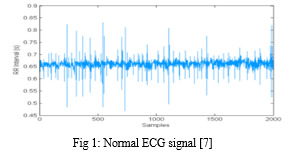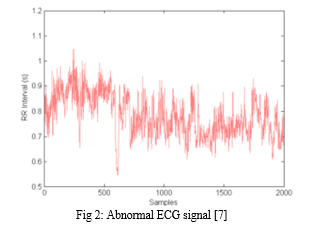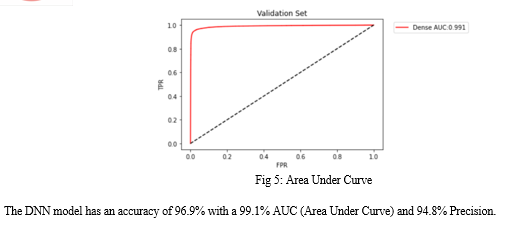Ijraset Journal For Research in Applied Science and Engineering Technology
- Home / Ijraset
- On This Page
- Abstract
- Introduction
- Conclusion
- References
- Copyright
ECG Analysis for Chronic Heart Failure Detection using Deep Learning
Authors: Ovee Manolkar, Namrata Gawande
DOI Link: https://doi.org/10.22214/ijraset.2023.53733
Certificate: View Certificate
Abstract
Chronic Heart Failure(CHF) is one of the leading causes for death all over the world. According to the American Heart Association, approximately 6.2 million adults in the United States have CHF; with more people being diagnosed every year. It is estimated that 1 in every 9 deaths is caused due to heart failure. CHF is caused due to various factors like coronary heart disease, diabetes, obesity, etc. Some of the conventional methods used for diagnosing CHF are ECG, blood tests, etc. The most common technique of heart disease detection is Electrocardiogram (ECG). It is a medical test that measures and records the electrical activity of the heart. The ECG signals can be analyzed using different algorithms like neural networks, Support Vector Machine (SVM), Random Forest, etc. In this study, the different techniques are analyzed and the most common algorithm is used to train the model.
Introduction
I. INTRODUCTION
Chronic Heart Failure (CHF), also known as Congestive Heart Failure, is a medical condition in which the human heart is unable to pump blood efficiently enough to meet the body’s needs. The term “chronic” implies that the condition usually worsens over time.
Chronic Heart Failure is generally caused by a combination of factors. Pre-existing medical conditions like: diabetes, high blood pressure, coronary artery disease, heart valve diseases, obesity can contribute towards the weakening of the human heart leading to its failure. Other major contributors to CHF are sleep apnea, drug or alcohol abuse and smoking, and higher stress levels.
In the traditional method for detecting heart abnormalities, some of the features used are age, sex, chest pain type(typical angina, non-typical angina or asymptomatic), serum cholesterol level, fasting blood sugar, resting ECG results, heart rate, etc. This requires a lot of different tests to be performed on a person. Some of these tests are: Electrocardiogram (ECG), Stress tests, Cardiac catheterization, several blood tests, CT scan or an MRI. The most commonly used technique is the Electrocardiogram (ECG).
An ECG is a medical test that measures and records the electrical activity of the heart. The test is commonly performed using a device called an electrocardiograph, which detects and amplifies the electrical signals produced by the heart.
The electrical activity of the heart is generated by specialized cells called pacemaker cells that initiate and regulate the heart's contractions. These electrical signals can be detected on the body's surface by placing electrodes on specific locations; and these electrodes are connected to the electrocardiograph, which records the electrical activity as a series of waveforms known as an ECG or EKG The ECG graphically represents the electrical activity of the heart over time. It consists of multiple waves and intervals that correspond to different phases of the cardiac cycle. The primary components of an ECG waveform include the P wave, QRS complex, and T wave, among others. The ECG is a valuable tool in diagnosing various heart conditions and assessing the overall health of the heart. It provides information about the heart's rhythm, rate, and electrical conduction, which can help detect abnormalities such as irregular heart rhythms (arrhythmias), heart attacks, conduction disorders, and other cardiac conditions.


In the recent developments, machine learning and deep learning methods have been used to analyse the ECG signals. By leveraging deep learning and machine learning techniques in ECG analysis, researchers and healthcare professionals can enhance the accuracy, efficiency, and diagnostic capabilities of heart disease detection. These approaches offer the potential for early detection, personalized treatment, and improved patient outcomes in the field of cardiology.
In this paper, a comprehensive study of the existing methods was done. The different techniques were studied, compared and reviewed. Based on the outcome of this analysis, the most efficient algorithm is used to train the model on the MIT-BIH Arrhythmia Database.
II. LITERATURE SURVEY
The paper "ECG Signal Classification with Deep Learning for Heart Disease Identification" [1] presents a study that uses deep learning techniques to classify electrocardiogram (ECG) signals for heart disease identification. It uses the 12 layer 1-d CNN model for ECG analysis which gives an accuracy of 97.7%.
The paper titled "Congestive Heart Failure Detection using Random Forest Classifier" [9] puts forth a study that focuses on the detection of congestive heart failure (CHF) using a random forest classifier. The results demonstrate that the random forest classifier achieves high accuracy of 92.2% in CHF detection, indicating its potential as an effective tool in diagnosing and managing this condition.
The paper titled "Detection of Abnormal Heart Conditions Based on Characteristics of ECG Signals" [11] presents a study that focuses on the detection of abnormal heart conditions using characteristics derived from electrocardiogram (ECG) signals. The model is trained using neural networks and algorithms like Support Vector Machine.
The paper titled "Empirical Analysis of Machine Learning Algorithms on Imbalance Electrocardiogram Based Arrhythmia Dataset for Heart Disease Detection" [18] presents an empirical analysis of various machine learning algorithms, like Decision Tree, Support Vector Machine and Artificial Neural Network, for heart disease detection using an imbalanced electrocardiogram (ECG) based arrhythmia dataset.
The paper titled "Development and Validation of Deep-Learning Algorithm for Electrocardiography-Based Heart Failure Identification" [20] presents the development and validation of a deep-learning algorithm based on Convolutional Neural Networks(CNN) for identifying heart failure using electrocardiography (ECG) data. The model has an accuracy of around 95%.
The paper titled "Coronary Heart Disease Diagnosis using Deep Neural Networks" [21] focuses on the diagnosis of coronary heart disease (CHD) using deep neural networks (DNNs). The model presents a diagnostic accuracy of 83.67%.
The paper titled "Cardiac Disorder Classification by Electrocardiogram Sensing Using Deep Neural Network" [22] presents a study focused on classifying cardiac disorders using electrocardiogram (ECG) sensing and deep neural networks (DNNs). The model illustrates an accuracy of around 95.20%
The paper titled "Application of deep learning techniques for heartbeats detection using ECG signals-analysis and review" [25] provides an analysis and review of the application of deep learning techniques like CNNs, RNN and DNN for heartbeats detection using electrocardiogram (ECG) signals. It is concluded that DNN has the highest accuracy of around 94.3%.
Table 1: Comparative Study
|
Sr. No |
References |
Algorithms |
Accuracy (%) |
F1 Score (%) |
|
1 |
[1] |
1-d CNN |
97.7 |
97.6 |
|
2 |
[9] |
RF |
92.2 |
98.5 |
|
SVM |
89.3 |
88.2 |
||
|
3 |
[11] |
DNN |
94.59 |
94 |
|
SVM |
93.25 |
95.2 |
||
|
KNN |
91.31 |
91.2 |
||
|
4 |
[18] |
DT |
93.5 |
96 |
|
SVM |
92.7 |
95 |
||
|
DNN |
93.8 |
96 |
||
|
5 |
[20] |
CNN |
95 |
89.2 |
|
6 |
[21] |
DNN |
83.67 |
85.4 |
|
7 |
[22] |
DNN |
95.2 |
91.6 |
|
8 |
[25] |
CNN |
92.6 |
91.3 |
|
DNN |
94.3 |
94.5 |
||
|
LSTM |
91.6 |
91 |
From the above study, it can be concluded that Deep Neural Network (DNN) is the algorithm that is most commonly used and presents the highest accuracy. Following are the reasons why DNN is preferred over other algorithms for ECG analysis:
- Ability to capture complex patterns: DNNs can automatically extract relevant features from the raw data enabling complex comprehensive analysis
- Handling high-dimensional data: As ECG signals typically contain high dimensional data with multiple channels and time series data, DNNs can be used to efficiently process and interpret the data.
- Continuous learning and improvement: DNNs can continuously learn and improve their performance with additional data and fine-tuning
III. METHODOLOGY
The methodology for heart disease detection using electrocardiogram (ECG) signals and deep neural networks (DNNs) typically involves the following steps:

A. Dataset Acquisition And Preprocessing
This step involves gathering a dataset of ECG recordings from individuals with and without heart disease. The next step is to pre-process the signals by removing noise, filtering and normalizing the data.
For the purpose of our project, the dataset used is MIT-BIH Arrhythmia Database, which consists of over 50 recordings. Each recording is associated with annotations and labels that indicate the presence and duration of specific arrhythmias and other relevant events. The recordings are stored in digital format (‘.dat’ files), with additional annotation files(‘.atr’ files)
B. Feature Extraction
Extract relevant features from the preprocessed ECG signals. Common features include heartbeat intervals, morphological patterns, statistical measures, and spectral characteristics. These features serve as inputs to the DNN model.
C. Dnn Architecture Design And Model Training
This step involves selecting an appropriate DNN architecture for heart disease detection. This can involve using various types of layers, such as convolutional layers We also consider the depth, width, and activation functions of the DNN model.
- DNN
A deep neural network (DNN) is a type of artificial neural network (ANN) that consists of multiple layers of interconnected nodes, called neurons. It is designed to mimic the structure and functionality of the human brain's neural networks.
In a DNN, information flows through the network in a forward direction, starting from the input layer, passing through multiple hidden layers, and ultimately reaching the output layer. Each neuron in the network receives input from the previous layer, applies a mathematical transformation (activation function) to the input, and produces an output that is passed to the next layer.
During the training process, the DNN adjusts these weights iteratively based on a comparison between the predicted output and the desired output, using techniques such as back propagation and gradient descent. This training process aims to minimize the difference (loss) between predicted and actual outputs
D. Model Evaluation
Evaluate the trained DNN model using the testing set. Calculate metrics such as accuracy, sensitivity, specificity, precision, and F1 score to assess the model's performance in heart disease detection.
E. Validation And Generalisation
Validate the DNN model on independent datasets to ensure its generalizability and reliability. Additionally, consider conducting cross-validation or employing techniques like k-fold validation to further validate the model's robustness.
IV. NEEDS AND SPECIFICATION FOR WATER PURIFICATION
In order to classify ECG signals to detect cardiac abnormalities; we use the Deep Neural Network on the MIT-BIH Arrhythmia Database. We use a confusion matrix and AUC metrics to evaluate the performance of the model.
A confusion matrix is a performance evaluation tool used in machine learning and statistics to assess the accuracy of a classification model. It provides a summary of the predicted and actual class labels for a set of data points.
AUC stands for Area Under the Curve, and it is a common metric used to evaluate the performance of a binary classification model. The AUC represents the overall performance of the model in terms of its ability to discriminate between positive and negative instances across different classification thresholds.


Conclusion
In conclusion, ECG analysis plays a crucial role in the detection of heart disease. The analysis of electrocardiogram (ECG) signals provides valuable insights into the heart\'s electrical activity and can help identify various cardiac conditions and abnormalities. Traditional methods of ECG analysis often require manual feature engineering and expert interpretation, which can be time-consuming and subjective. However, with the advent of deep learning and machine learning techniques, ECG analysis has witnessed significant advancements. Deep learning models, such as deep neural networks (DNNs), have shown promise in automatically learning and extracting relevant features directly from raw ECG data. These models can capture complex patterns, temporal dependencies, and inter-lead correlations, leading to improved accuracy in heart disease detection. Machine learning algorithms also contribute by providing efficient classification and prediction capabilities based on extracted features. By leveraging deep learning and machine learning techniques, ECG analysis for heart disease detection benefits from automatic feature extraction, adaptability to new data, ability to handle high-dimensional data, and continuous learning and improvement. These advancements have the potential to assist healthcare professionals in making accurate diagnoses, enabling early detection and personalized treatment for patients with heart disease. With on-going research and advancements in the field, ECG analysis using deep learning and machine learning continues to show promise in improving cardiac healthcare outcomes and enhancing patient care.
References
[1] Wenbo Zhang et al., “ECG Signal Classification with Deep Learning for Heart Disease Identification”, IEEE, 2018 [2] Joseph J. Oresko et al., “A Wearable Smartphone-Based Platform for Real-Time Cardiovascular Disease Detection Via Electrocardiogram Processing”, IEEE, 2010 [3] Zeinab Arabasadi et al., “Computer aided decision making for heart disease detection using hybrid neural network-Genetic algorithm”, Elsevier, 2017 [4] Ertan Butun et al., “1D-CADCapsNet: One dimensional deep capsule networks for coronary artery disease detection using ECG signals”, Elsevier, 2020 [5] Adyasha Rath et al., “Heart disease detection using deep learning methods from imbalanced ECG samples”, Elsevier, 2021 [6] M.Vijayavanan et al., “Automatic Classification of ECG Signal for Heart Disease Diagnosis using morphological features”, IJCSET, 2014 [7] V. Jahmunah et al., “Computer-aided diagnosis of congestive heart failure using ECG signals – A review”, Elsevier, 2019 [8] Roberta Avanzato et al., “Automatic ECG Diagnosis Using Convolutional Neural Network”, MDPI, 2020 [9] Zerina Masetic et al., “Congestive Heart Failure Detection using Random Forest Classifier”, Computer Methods and Programs in Biomedicine, 2016 [10] U. Rajendra Acharya et al., “Entropies for automated detection of coronary artery disease using ECG signals: A review”, Elsevier, 2018 [11] Mohamed Hammad et al., “Detection of Abnormal Heart Conditions Based on Characteristics of ECG Signals”, Measurement, 2018 [12] Taotao Liu et al., “Inter-Patient Congestive Heart Failure Detection Using ECG-Convolution-Vision Transformer Network”, MDPI, 2022 [13] Peng Wang et al., “A Wearable ECG Monitor for Deep Learning Based Real-Time Cardiovascular Disease Detection”, arXiv, 2022 [14] Muhammad Salman Haleem et al., “Time adaptive ECG driven cardiovascular disease detector”, Elsevier, 2021 [15] V. Jahmunah et al., “Automated detection of coronary artery disease, myocardial infarction and congestive heart failure using GaborCNN model with ECG signals”, Elsevier, 2021 [16] U Rajendra Acharya et al., “Deep convolutional neural network for the automated diagnosis of congestive heart failure using ECG signals”, Springer, 2018 [17] Muhammad Shabaan et al., “Survey: smartphone-based assessment of cardiovascular diseases using ECG and PPG analysis”, BMC, 2020 [18] Shwet Ketu et al., “Empirical Analysis of Machine Learning Algorithms on Imbalance Electrocardiogram Based Arrhythmia Dataset for Heart Disease Detection”, Springer, 2021 [19] Jie Zhang et al., “Method of diagnosing heart disease based on deep learning ECG sign”, arXiv, 2019 [20] Joon-myoung Kwon et al., “Development and Validation of Deep-Learning Algorithm for Electrocardiography-Based Heart Failure Identification”, Korean Circulation Journal, 2018 [21] Kathleen H. Miao et al., “Coronary Heart Disease Diagnosis using Deep Neural Networks”, IJACSA, 2018 [22] Ali Haider Khan et al., “Cardiac Disorder Classification by Electrocardiogram Sensing Using Deep Neural Network”, Hindawi, 2021 [23] Lotfi Mhamdi et al., “Artificial Intelligence for Cardiac Diseases Diagnosis and Prediction Using ECG Images on Embedded Systems”, MDPI, 2022 [24] Fatma Murat et al., “Exploring Deep Features and ECG Attributes to Detect Cardiac Rhythm Classes”, Knowledge-Based Systems, 2021 [25] Fatma Murat et al., “Application of deep learning techniques for heartbeats detection using ECG signals-analysis and review”, Elsevier, 2020
Copyright
Copyright © 2023 Ovee Manolkar, Namrata Gawande. This is an open access article distributed under the Creative Commons Attribution License, which permits unrestricted use, distribution, and reproduction in any medium, provided the original work is properly cited.

Download Paper
Paper Id : IJRASET53733
Publish Date : 2023-06-05
ISSN : 2321-9653
Publisher Name : IJRASET
DOI Link : Click Here
 Submit Paper Online
Submit Paper Online

